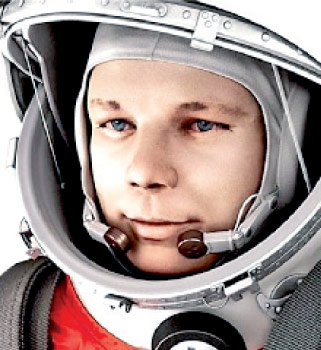The first man to travel into space - Yuri Alekseyevich Gagarin
Yuri Alekseyevich Gagarin was the first person to travel into the
outer space. He travelled to the space when his 'Vostok' spacecraft
completed an orbit of the Earth in 1961. Gagarin was born on March 9,
1934 and died on March 27, 1968 when the MiG-15 training jet which he
was piloting crashed. He was a Russian Soviet pilot and a cosmonaut.
The American plan to send a man into space by 1961 created a deadline
that the Russian team worked hard to beat. The development of the 'Vostok'
spacecraft became paramount. Prior to Gagarin's historic flight, the
Soviets sent a prototype of his spaceship along with a life-size dummy
called Ivan Ivanovich and a dog called Zvezdochka. The vessel was
considered ready to take a living, breathing human into space with
success.

More than 200 Russian Air Force fighter pilots were selected as
cosmonaut candidates. Such pilots were considered optimum because they
had exposure to the forces of acceleration and experience with
high-stress situations. Among the pilots was 27-year-old Senior
Lieutenant Yuri Alexeyevich Gagarin.
The third of four children, Gagarin was born in a small village, a
hundred miles from Moscow. As a teenager, he witnessed a Russian Yak
fighter plane make an emergency landing near his home. When offered a
chance years later to join a flying club, he eagerly accepted making his
first solo flight in 1955. Only a few years later, he submitted his
request to be considered a cosmonaut.
The 'Vostok 1' spacecraft blasted off from the Soviets' launch site
on April 12, 1961 at 9:07 a.m. If an emergency arose, Gagarin was
supposed to receive an override code that would allow him to take manual
control, but Sergei Korolov, chief designer of the Soviet space program
disregarded protocol and gave it to the pilot prior to the flight.
Over the course of 108 minutes, 'Vostok 1' travelled around the Earth
once, reaching a maximum height of 203 miles (327 kilometres). Over
Africa, the engines fired to bring Gagarin back to Earth. The craft
carried ten days' worth of provisions in case the engines failed and
Gagarin was required to wait for the orbit to decay naturally, but they
were unnecessary. Gagarin re-entered Earth's atmosphere, experiencing
forces up to eight times the pull of gravity but remained conscious.
Upon his return to Earth, Gagarin became an international hero. He
was cheered in the Red Square by a crowd of hundreds of thousands. He
travelled around the world to celebrate the historical Soviet
achievement.
On returning home, he became a deputy of the Supreme Soviet and was
appointed Commander of the Cosmonauts' Detachment. As Russia did not
want to risk such a public figure, they were hesitant to allow him back
into space. He continued to make test flights for the Air Force.
Gagarin was married to Valentina Ivanovna Goryacheva and had two
daughters. One of Gagarin's most notable traits was his smile. Many
commented on how Gagarin's smile gained the attention of crowds on the
frequent tours he did in the months after the 'Vostok 1' mission
success.
Gagarin became popular worldwide and was awarded many medals and
titles. He was titled as a Hero of the Soviet Union which was considered
the nation's highest honour. Gagarin's spacecraft was 'Vostok 1' but he
served as backup crew to the Soyuz 1 mission.
Gagarin later became the deputy training director of the Cosmonaut
Training Centre which was later named after him. The Yuri Gagarin Medal
is awarded in his honour.
- Internet |

